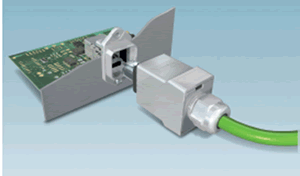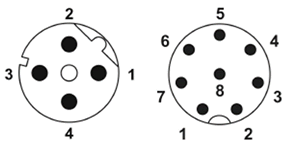M12 Versus RJ45 Ethernet Connections on the Factory Floor
When it comes to surviving in a hostile plant environment, few would argue against the superiority of the M12 connector system over the traditional RJ45 connector and socket, according to Dietmar Röring of Phoenix Contact.
Ethernet has become a viable alternative to fieldbus systems in industrial networks. Ethernet can also be combined with existing fieldbus systems through its standardized IEEE 802.3 format. This compatibility allows for full vertical integration in systems, from sensors to the controller level and higher. Many network infrastructure components, such as switches, have been adapted for use in the industrial environment. However, when the discussion focuses on active components, the importance of the associated connection technology is often neglected.
The network plugs and sockets used so effectively and cheaply in the office are often not suitable in industrial systems where the connections are frequently subjected to humidity, drastic temperature changes, vibration, and shock. So which type of plug connector is suited best to industrial Ethernet networks? Unfortunately, there is no definitive answer to this question. Rather, the cabling concept needs to be adapted to the system’s requirements according to the individual advantages offered by the different types of plugs and connectors.
RJ45 or M12?
RJ45 plug connectors, which conform to the IEC 60603-7 standard, are the most widely established connection technology for Ethernet systems. These eight-pin components are widely used and are available for both Cat5 and Cat6 (IEC 11801:2002).

Figure 1: The RJ45 push–pull locking connector for Profinet systems was jointly designed for production by Phoenix Contact and HARTING.
In 2002, the PROFIBUS User Organization (PNO) specified a new RJ45 push-pull locking connector for PROFINET systems, which was then jointly designed for production by Phoenix Contact and HARTING (see Figure 1). This push-pull plug connector is available with a plastic or metal housing and complies with protection class IP67. Since then, AIDA (the Automation Initiative of Domestic Automobile Manufacturers, Germany) has also approved this plug connector for use in PROFINET systems.
For Ethernet networks that must comply with protection class IP67, M12 plug connectors represent an attractive alternative to RJ45 and are frequently more suitable.
The M12 four-pin plug connector with D-coding has already been defined as an Industrial Ethernet standard according to IEC 61067-2-101 Amendment 1 (see Figure 2). PNO also supports the use of this connector type and has included it within its PROFINET cabling specifications alongside the RJ45 push-pull connector. M12 connection technology is well established in sensor-actuator and fieldbus cabling and provides several advantages in industrial environments.

Figure 2: Pin configurations for M12 Ethernet connectors include (left) four-pin/D-coded and eight-pin/A-coded. There is still no agreed-upon standard on wiring an eight-pin variant for Industrial Ethernet.
Even though they are IP67-compliant, M12 connectors have a compact design. In keeping with the growing trend toward miniaturization, this makes them particularly attractive to equipment manufacturers that develop small-scale products. M12 connectors are very sturdy despite their small size, and they provide a reliable connection even when subjected to shock or vibration.
However, not every M12 connector is suitable for Ethernet systems. Ethernet transmission has to comply with Cat5 (IEC 11801:2002), and the contact geometry of standard M12 connectors is only partially compatible with this. Connection mechanisms such as spring cages, for example, may cause an electrical imbalance and so adversely affect transmission properties such as return loss. In order to ensure full Cat5 compliance, it is necessary to compensate these negative side effects. Properly designed Industrial Ethernet M12 components are specifically designed to overcome this kind of shortcoming and so consequently provide faultless transmission.
Four-pin or Eight-pin M12?
Fast Ethernet (100Base-T) employs one data pair for sending and one data pair for receiving, both at a transmission rate of 100Mb/s. Four-pin M12 connectors with D-coding are perfectly adequate for Fast Ethernet transmission. Eight-pin connectors are only necessary for higher transmission rates such as Gigabit Ethernet (1000Base-T), which transmits at 1000Mb/s. For Gigabit Ethernet, all four-wire pairs are used to send and receive in full-duplex mode. The transmission properties specified in IEC 11801:2002 Cat5 also cover Gigabit Ethernet.
As yet, there is no standard eight-pin connector footprint coded specifically for Ethernet. Ethernet cabling with eight-pin M12 connectors usually employs the same A-coding that is used for sensor-actuator cabling. This approach eliminates any confusion with B-coded eight-pin connectors, which are designed for fieldbus systems.

Figure 3: A range of four-pin and eight-pin M12 components for Cat5-compliant Ethernet connections are shown here. M12 connectors can be assembled as quickly as RJ4 product without special tools in situ.
For Power-over-Ethernet applications, according to IEEE 802.3af, there are two main types of transmission – supply voltage and data are either transmitted together (type 1) or separately (type 2). Four-pin M12 connectors are only suitable for type 1 transmission; the supply voltage has to be superimposed upon the two data pairs. In Fast Ethernet systems constructed with eight-pin connectors, the two spare wire pairs can be used to transmit the supply voltage separately.
So which type of plug connector is best suited to Industrial Ethernet? This is a question customers need to address on a case-by-case basis, as neither M12 nor RJ45 represent a connection solution that will suit all Ethernet systems. In the future, Industrial Ethernet networks will increasingly combine RJ45 and M12 connection technologies to suit the requirements at hand.
Author Dietmar Röring is global key account manager for Phoenix Contact GmbH & Co. KG in Blomberg, Germany.




